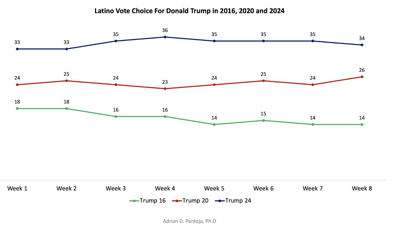The dust has yet to settle on the 2024 election, yet much is being written about Latino voters and their unexpected support for Trump. As a pollster and expert on Latino voters, I have a few thoughts on their voting behavior in this election.
First, 46% of Latinos did not vote for Trump. As in past elections, the exit polls are widely off the mark when it comes to Latino voters. The best estimates have him winning between 34% to 37% of the Latino vote. While Trump did not win 46% of Latino voters, his share of their vote has dramatically increased since 2016. Based on tracking poll data that I carried out for various Latino organizations since 2016, Trump’s Latino support increased 20-points between 2016 and 2024.

Chart created by Adrian D. Pantoja, PhD.
How is it possible that a candidate who threatens immigrants gained traction with Latino voters? How does a candidate whose policy priorities are misaligned with those of Latinos manage to win the hearts and minds of so many?
The ability of candidates like Trump to take away Latino support from the Democratic Party suggests that Hispanic ties to the Democrats is rather precarious. As a professor who spends a great deal of time with young people, I often hear Latino students say that the Democratic Party takes Hispanic voters for granted. It’s hard to dispute that claim when polling data shows that Latinos across the nation feel the same way. For example, in the 2024 American Electorate Voter Poll, 39% of Latinos said Kamala Harris and the Democratic Party either “don’t care too much” or are “being hostile.”
The Trump campaign took a look at this number and saw an opportunity. Indeed, their share of the Latino vote in 2024 closely mirrors that figure. This should be a wakeup call to Democrats and liberals who think that Latinos will back the party and candidates simply because they have nowhere else to go.
Latinos have broken up with the Democratic Party many times prior to 2024, and it is worth revisiting these moments to evaluate how the present is similar to or different from the past. Perhaps one of the most dramatic break ups happened in the early 1970s when young Mexican American and Chicano activists created a third party in South Texas – La Raza Unida Party. Seeing that the Democratic Party had done little to improve the lives of Mexican Americans in Texas, young Chicanos embarked on a bold plan to seize political power through an independent third party. As an independent party, La Raza Unida scored a number of impressive victories in South Texas up until the mid-1970s.
Our winner-take-all electoral system makes it difficult for third parties to win electoral contests, even at a local level. As a consequence, the next two break ups with the Democratic Party led Latinos to do what many considered to be unthinkable – support the Republican Party. In 1984, Ronald Reagan won an estimated 37% of Latino voters and in 2004 George W. Bush increased his support to 40%. Again, in both cases, the lackluster outreach by the Democratic Party and a belief that they had done little to improve the lives of Latinos created opportunities for Republicans to win over significant numbers of Latino voters.
The next breakup occurred during the 2019 primaries when Bernie Sanders won a significant number of Latino voters against Joe Biden. Does Bernie running as a Democrat challenge my hypothesis about the lack of Democratic Party voter engagement? No, because Bernie was hardly part of the Democratic Party establishment, and he was not the preferred choice for the party’s leadership. At the time, I wrote that Bernie Sanders was winning California’s Latino voters decisively because his campaign was going beyond the symbolic outreach efforts that traditionally characterize other Democratic campaigns. Bernie’s presidential campaign advisor Chuck Rocha’s book, “Tío Bernie,” would later confirm the extent to which Bernie Sanders’ campaign engaged Latino voters during the primaries.
The 2024 Election marks the fifth time in which significant numbers of Latinos have broken up with the Democratic Party and their candidates. It would be easy to say, they’ll be back, just like they have in the past. However, there is something different about the current split from the Democratic Party. The previous cases were one-off events that are typical of presidential elections. In this case, Trump’s and the Republican Party’s support has been an incremental process that started in 2016. Voter registration data from deep-blue California confirms that Latinos have been registering for the Republican Party in greater numbers for some time. Latino voting behavior in Texas also points to a gradual drift toward the Republican Party. All of this is to say that the shift seems more permanent this time around.
For over two decades, pollsters and experts on Latino voters have exclaimed that the Latino vote was “up for grabs.” Those words continuously fell on deaf ears. Many liberal elites within or outside of the Democratic Party have simply responded by asking, where are they going to go – to the Republican Party? My response is, absolutely! They have in the past and they will again as long as you take them for granted. But unlike in the past, Latinos are politically powerful, and their electoral strength will grow into the foreseeable future. Ignore them at your peril.










(0) comments
Welcome to the discussion.
Log In
Keep it Clean. Please avoid obscene, vulgar, lewd, racist or sexually-oriented language.
PLEASE TURN OFF YOUR CAPS LOCK.
Don't Threaten. Threats of harming another person will not be tolerated.
Be Truthful. Don't knowingly lie about anyone or anything.
Be Nice. No racism, sexism or any sort of -ism that is degrading to another person.
Be Proactive. Use the 'Report' link on each comment to let us know of abusive posts.
Share with Us. We'd love to hear eyewitness accounts, the history behind an article.